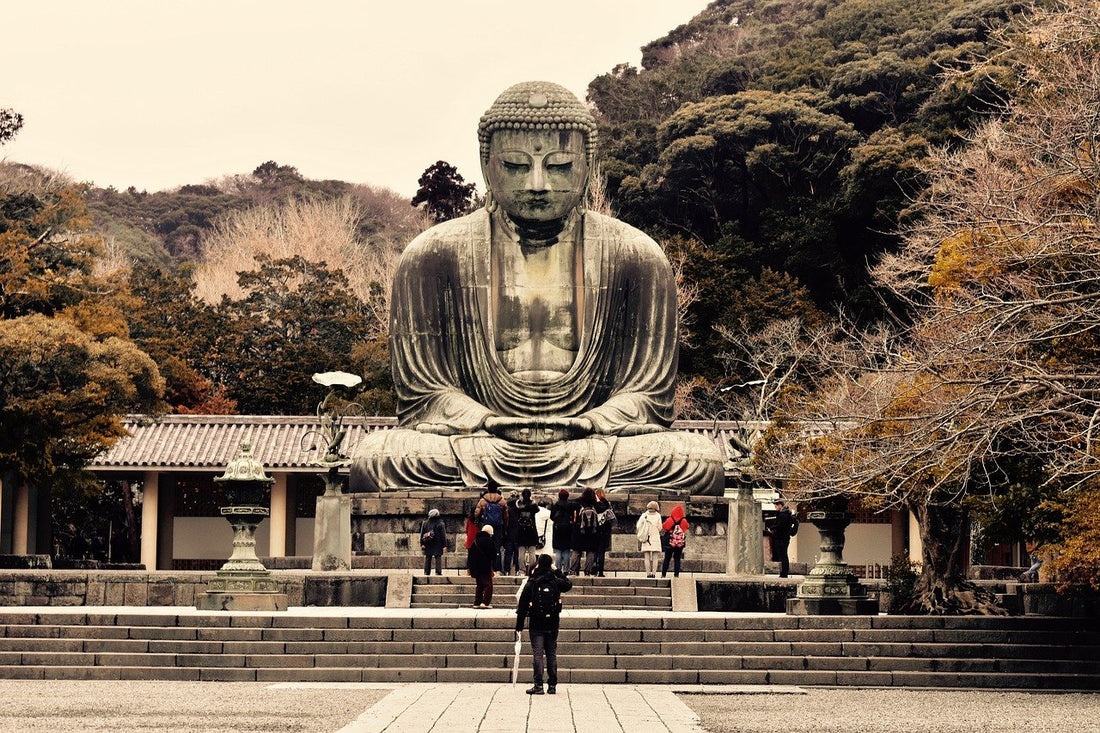According to tradition the founder of Buddhism, Siddartha, was born in 563 BCE in what is now considered to be southern Nepal. He was a prince who, after discovering the suffering of those less fortunate, left the palace behind to become a wandering monk. After many years of wandering and learning he found an awakening. When this happened he died and reached what is called nirvana or enlightenment. After his death his teachings were written down by his followers. These teachings became known as sutras. They were then formally assembled into an organized religion known as Buddhism.

There are a few different schools of Buddhism, one being Mahayana Buddhism. In Mahayana Buddhism it is believed that anyone can reach Nirvana through meditation and mindfulness. Mahayana Buddhism was introduced to Japan in the 6th century. According to the “Nihon Noki”, the second oldest Japanese chronicle, Buddhism was officially introduced to Japan in the year 552 during a diplomatic mission to bring images of the Shakyamuni Buddha along with several volumes of Buddhist texts.
Despite the fact that Buddhism is deeply ingrained in Japanese life now, its introduction was a little rocky. While there was never an official war, opposing clans often blamed Buddhism for anything bad that happened in the region, such as an epidemic. This began to change in 592 when Empress Suiko took the throne as she had taken the vow of a Buddhist nun. Furthermore, the next ruler, Prince Shotoku, was a practitioner of Buddhism and therefore was a major advocate for the religion. There are many legends that surround Shotoku and Buddhism. Some say he had met with Daruma, the founder of Zen Buddhism, others say he was an incarnation of Kannon the Bodhisattva of mercy and compassion. Whether you believe those legends or not, it cannot be denied that he was fundamental in the establishment of Buddhism in Japan. He commissioned a multitude of Buddhist temples, the most famous being Shitenno-Ji in Osaka and Horyu-Ji in Nara Prefecture.
During the 8th and 9th centuries Buddhism and Shinto began to grow together. Over time the two religions began to grow closer over shared philosophical grounds and soon both became entrenched in peoples’ everyday lives. Buddhist temples were being built next to Shinto shrines and different symbols from each religion began to become rooted in the other. For example, “chozuya” a Shinto water ablution began being built outside of Buddhist temples and “komanu” Buddhist Lion Dogs began being built outside of Shinto Shrines.

In 1808 began the Meiji Restoration and the downfall of the Shogunate. The emperor was put back in place and the new nationalist government began separating Buddhism and Shinto. Shinto was labeled as the true Japanese religion while Buddhism was labeled the foreigner. The “Kami and Buddhas Separation Order” made the religions completely separate. Buddhist priests were no longer able to practice at Shinto shrines and all Buddhist artifacts were forcibly removed from shrines. In an effort to seem like good devoted citizens to Japan, many Buddhists supported the modernization and militarisation of Japan during this time. Beginning with the Japanese invasion of Manchuria in 1931, Buddhism began to become closely tied with the imperial army. Throughout the 15 year war the government attempted to control Buddhism and demanded that all materials that could possibly disavow the government be taken down.
Following the end of the war, much of Japan had been bombed leaving most cities in ruins. The occupational government abolished the State of Shinto making the country free for all religious practice. However, due to the heavy involvement and support of the Japanese military, many Buddhists spent these years paying repentance to the people of Japan. In the 1960s Buddhist temples began performing funeral rites, many of which are still performed today.
In modern Japan Buddhism is still prevalent. While most young people in Japan would not consider themselves religious, many people have small Buddhist altars in their homes, and there are many beautiful Buddhist temples across the country.



1 comment
Hi, Very interesting about Buddhism. There is a big practice of Buddhism, which at the heart of it is the Lotus Sutra and nam myo renge kyo. It is for all the people whoever and wherever they are.
thank you,
Susan